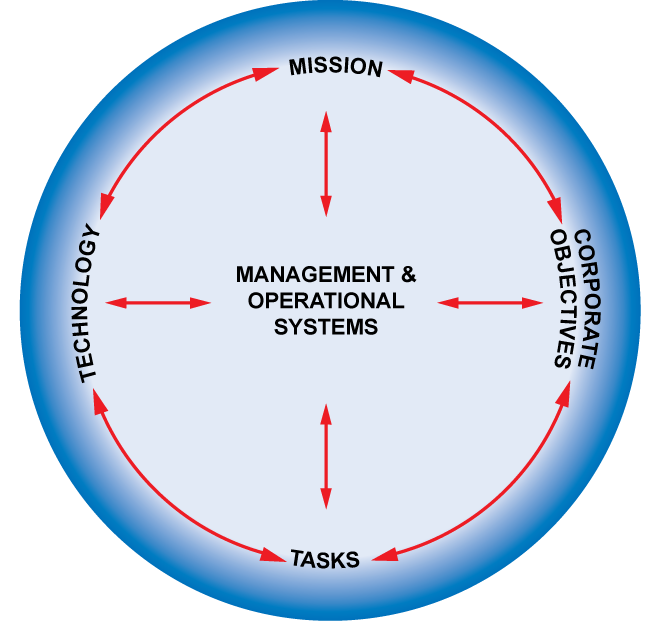Exemplary workers
understand what is important to the organization so they put their efforts in
the right places, do the right things, and make decisions in the best interests
of their organizations. To be exemplary performers, workers need a general
understanding of organizations and a specific understanding of their
organization. The same goes for Trainers and performance consultants: to
develop effective customized training—training that is relevant, useful, and
practical, and reflects the organization for what it is—they too need a general
understanding of organizations. Both exemplary workers and training/performance
consultants benefit from an understanding of relationships between business
resources, organizational structure, business strategies, corporate objectives,
and performance standards.
This understanding
of an organization forms the basis for exemplary workers to learn how their
line of work and position fits into the organization as a whole. They
appreciate how their work affects others and can make better use of
organizational resources. Understanding organizations also helps training and
performance consultants (and technical writers) to be more effective at
designing and developing training that is customized, reflects the business,
and has excellent value for the customer.
| When explaining organizations
to consultants new to our firm, I pretend to build a new business. Would the
line of business be a service or a product? What is its mission? If the
business is a service, then performing tasks is the main way to generate
revenue; tools/equipment provide support for carrying out the work. If the line
of business uses technology to make products (e.g., petro-chemical industry),
then the technology dictates many of the tasks that workers must do. Having
resources to achieve specific results is essential but not sufficient for
business success. The resources must also be managed effectively. The illustration
identifies some key constituents of a business. | 
|
Of particular
interest to workers, trainers, and development consultants are the corporate objectives. Corporate objectives
provide direction for using technology, performing tasks, coordinating work to effectively
achieve the mission, and developing relevant training. The following table
lists areas of concern common to many organizations for which corporate
objectives may be developed.
|
Areas addressed by Corporate
Objectives
|
|
•
safety
•
environment
•
legislation
•
equipment reliability and life
•
equipment optimization
•
energy use
•
quality
•
waste control
|
•
loss control
•
cost control
•
customer satisfaction
•
public image
•
public disruption
•
reputation
•
communication
•
teamwork
|
A list of the areas
addressed by corporate objectives can be generated by expanding the
organization’s strategic business objectives or by using
LO-PEMEO (see previous post). Some organizations issue strategic business objectives to identify what
it must do well to be successful and to give employees direction about where to
put their energy and focus. For example, leaders in an organization may believe
reliable service and satisfied customers is essential for business success. Organizations
may identify five to eight strategic objectives. Within a department, the list
of objectives may be expanded to address issues specific to the department’s
mandate. Key Performance Indicators may be created for the department to assess
how well the department is doing to contribute to business success.
The expanded list of
corporate objectives can also be generated using LO-PEMEO—each of the items in
the above table relates to one or more of the LO-PEMEO domains.
Corporate objectives
are fundamental to exemplary performance because they define what is important to the organization, the job, and workers.
Corporate objectives provide a formal link between
organizational goals and worker performance. Workers can use corporate
objectives as criteria for working effectively and efficiently and for making decisions
in the best interest of their organizations. Training and performance consultants
can use corporate objectives to identify relevant, useful, and practical
training content so that the training contributes to business success.
For exemplary
performance, workers need to understand the relationship between the
constituents of the business model. For example, how and how well a task is to
be performed is influenced by the technology, corporate objectives, and
expectations of the supervisor or manager. The book JobThink provides a detailed explanation of the business
model. A strong emphasis is placed on the interrelationships of the
constituents. For workers, a practical understanding of their organizations
helps them to effectively focus their efforts and make decisions in the best
interests of their organizations.
Refer to the book, Interviewing to Gather Relevant Content for Training for:
- information about applying
critical thinking skills to identify relevant content for training
- an interviewing process
that training and performance consultants and technical writers can use to interview
subject matter experts (SMEs) to gather relevant content
The books use an educational design and have exercises to apply the
thinking to the world of work.
Does this model
integrate the key aspects of your organization that you need to take into
account when working and making decisions?
Gordon Shand is
President of HDC Human Development Consultants Ltd. He has 35 years of
experience designing and developing educational and training programs that have
excellent practical value and contribute to the customer’s business success. www.hdc.ca